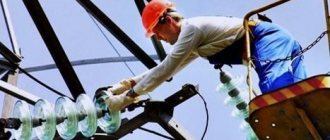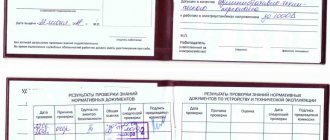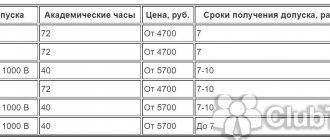- Conducting training for welders
- Certification of electric welders for electrical safety
Welding work requires special registration of permits. In our company you can receive a complete set of necessary documentation in the shortest possible time. Our specialists carefully monitor all changes in legislation regulating this subject area. Thanks to this, you can be sure that the documents for your specialists are in perfect order. This will give you peace of mind when carrying out any inspections, and also guarantees the safety of the work performed.
Appointment of responsible persons
The most important link in the chain of measures to ensure the correct operation of electrical installations is the appointment of responsible persons. Clause 1.2.3 of the Rules clearly prescribes the appointment of a person responsible for electrical equipment and his deputy for the direct performance of duties.
If the installed power of the electrical installation does not exceed 10 kW, a deputy responsible may not be appointed. If the owner of an electrical installation is not engaged in production activities, and the electrical equipment includes only an input distribution device, lighting installations and portable electrical equipment with a voltage not exceeding 380 V, then the person responsible for the electrical equipment may not be appointed at all, and the responsibility can be assumed by the head of the organization by written agreement with Rostechnadzor. In the latter case, no training or knowledge testing is required. (The application form is set out in Appendix No. 1 to PTEEP).
Very often the line between production and non-production activities is blurred, and not every manager will want to voluntarily take on additional responsibility, and also report this to the Rostechnadzor body. Therefore, in this article we will consider the usual practice in production with the appointment of a person responsible for electrical equipment and those of his actions that are prescribed by these PTEEP.
Electrical safety requirements for welding equipment
An electric welding installation (welding transformer, unit, converter, rectifier) must have a passport, operating instructions and an inventory number under which it is recorded in the logbook and periodic inspections.
Transformers, rectifiers and direct current generators specially designed for this purpose can be used as sources of welding current. Direct supply of the welding arc from the power (or lighting) workshop distribution network is not allowed. Welding-type sources can be connected to electrical distribution networks with a voltage not exceeding 660 V. The load of single-phase welding transformers is evenly distributed between the individual phases of a three-phase network.
In mobile electric welding installations, to connect them to the network, it is necessary to provide for blocking switches, eliminating the possibility of connecting and disconnecting the wire when the clamps are energized.
Electric welding installations must be connected to and disconnected from the electrical network, and repaired only by electricians. Welders are prohibited from performing these operations. The length of the primary circuit between the power point and the mobile welding unit should not exceed 10 m.
Current-carrying parts of the welding circuit must be reliably insulated (insulation resistance must be at least 0.5 MOhm) and protected from mechanical damage. The insulation resistance of the electrical circuits of the installation is measured during routine repairs in accordance with GOST for operating electric welding equipment. The timing of current and major repairs of welding installations is determined by the person responsible for the electrical equipment of the enterprise, based on local conditions and operating conditions, as well as the instructions of the manufacturer. The installation and its starting equipment should be inspected and cleaned at least once a month. All open parts of the welding installation under mains voltage are securely fenced.
The insulation resistance must be checked at least once every three months, and for automatic submerged arc welding - once a month. The insulation must withstand a voltage of 2 kV for 5 minutes.
The housings of electric welding equipment are grounded (grounded). For protective grounding (grounding) of the housing, power supplies equipped with special bolts are connected to the wire of the grounding (grounding) device. In this case, each welding installation must be directly connected to the neutral (grounding) wire. Serial connection of installations to each other and the use of a common neutral (grounding) wire for a group of installations is not allowed. Failure to comply with this requirement may lead to the fact that if the wire connecting the units in series breaks, some of them will not be zeroed.
Electrical staff
Everything is relatively simple with him. If an employee has the position of electrician, electrician, etc., if he is an engineer and technical worker and is appointed responsible for electrical equipment or is a deputy responsible, then, accordingly, he performs his production function - operation of an electrical installation, and therefore must have an appropriate group for electrical safety. For the person in charge and his deputy, when working in electrical installations up to 1000 V, this is group IV, above 1000 V - V. Maintenance and operating personnel must have groups from II to IV, depending on the nature of the work performed.
As a rule, electrical personnel undergo initial training at a training center according to a 72-hour program, after which they pass an exam and receive Group II in electrical safety. After two months, he can be certified to III, and then after another three months to IV electrical safety group. In any case, repeated knowledge testing is established once a year. That is, once a year, an employee must, by passing an exam, confirm his knowledge in the field of electrical safety to the extent that his existing group corresponds. The examination commission constantly operates in the branches of Rostechnadzor and in accredited training centers, or can be created at the enterprise [Clause 1.4.30 of the Rules].
What is an electrical safety permit for welders?
Upon receipt of a welder's certificate (it does not matter whether it is an electric welder or an electric and gas welder), the specialist receives the right to perform welding work, i.e.
he becomes a full-fledged participant in welding production. BUT! He seems to have the right to cook, but he doesn’t have the right to hold a welding machine powered by electric current. Why is that? We still have not received a response from the legislative authorities. It seems that a welder’s certificate gives the right to perform welding work, a firefighter’s certificate gives the right to perform hot work, but without an electrical safety permit, that’s all.
We proposed to conduct additional training for the above-mentioned specialists in electrical safety (as well as additional hours in fire safety), and to register admission directly to the main “crust”, but in response there has been silence so far, which means we will act in accordance with the still existing regulatory requirements. The main standard regulating this issue is Order of the Ministry of Energy of Russia dated January 13, 2003 N 6 (as amended on September 13, 2018) or simply PTEEP.
It clearly states which tolerance group a welder must have in certain production processes. PTEEP is not a recommended standard, but a mandatory one, i.e. required for execution.
It follows that a welder (electric or gas-electric) can be allowed to work using a power tool (an electric welding machine belongs to this category) only after receiving an electrical safety permit.
Conclusion: an electrical safety permit for welders is nothing more than a permit to perform work using welding equipment powered by electrical energy, required in accordance with regulatory requirements. Registered in a specialized certificate.
Sample electrical safety permit for welders
A sample electrical safety permit for all specialists (including welders) is indicated in Order 903n in the Appendix. This is a booklet on a thick cardboard base of red color (maybe brown) with a pasted block of pages where the necessary data is written down.
In general, everything is the same as what I wrote about in the last article (the link to it is just below).
On the first page there is a photo of the employee (optional, at the discretion of the head of the organization), date of issue, personal signature of the employee, etc.
On the second - full name of the employee, position held (usually electric welder, electric and gas welder), assigned personnel (repair, operational and repair, depending on the work performed), etc.
On the third, the assigned tolerance group: II for working with electric welding or III for connecting it.
The welder usually does not need to fill out the remaining pages. In general, this document does not differ much from the permit for electricians.
Non-electrical personnel
According to clause 1.4.4. PTEEP, non-electrical personnel includes personnel performing work that may pose a risk of electric shock. In the age of the spread of electricity into all spheres of human life, it is difficult to imagine a situation in which a person can be completely protected from electric shock. If an accident occurs, it will be extremely difficult to prove that the victim was not trained because the electrical supervisor did not see the risk of electric shock in the work assigned to the employee. Moreover, nothing complicated is required to carry out certification for electrical safety group I, which is assigned to non-electrical personnel. In accordance with clause 1.4.4 of the PTEEP, it is necessary to appoint a responsible person from among the electrical personnel with group no lower than III, develop a Training Program and keep a log of assignment of group I for electrical safety. Then, once a year, all employees who, by decision of the Organization, are classified as non-electrical personnel must listen to the instruction of the person in charge, take part in an oral survey and sign in the log that the instruction was completed.
Conducting training for welders
The procedure for performing welding using electrical equipment is regulated by the provisions of Order No. 6 of the Ministry of Energy. This regulatory document in paragraph 1.4.3 establishes that this type of activity is classified as complex along with electrolysis, electrothermal and other special operations. This means that only specially trained electrical personnel are authorized to carry out such work. Specific requirements for the level of such training are specified in paragraph 3.1.15 of this legal act. This section of the order determines that in order to obtain permission to carry out work, an electric welder must undergo:
- instruction on the procedure for performing the necessary work;
- training in the field of electrical safety during labor operations;
- checking the level of acquired knowledge and skills;
- the procedure for assigning the required group with the issuance of the corresponding electrical safety welder certificate.
Electrotechnological personnel
The situation is completely different with the Electrotechnological personnel. According to the definition, Electrical Technological Personnel means personnel of production workshops and areas that are not part of the energy service of the organization, operating electrical technological installations and having electrical safety group II and higher (in their rights and responsibilities they are equal to electrical personnel and are technically subordinate to the energy service of the enterprise) ; personnel whose main component in the technological process they control is electrical energy (for example, electric welding, electric arc furnaces, electrolysis, etc.), who use hand-held electric machines, portable power tools, lamps, etc. in their work. I deliberately use the second part of the definition highlighted because it is with this that significant leapfrog and confusion in categorization are associated. Who is classified as non-electrical and electrical technical personnel? This question will first have to be answered by the one who will compile the “List of Positions...”. The gradation is fully entrusted to the employer and the person authorized by him. There are also errors that the inspector can point out... The main thing is to understand that, first of all, electrical engineering personnel include persons who cannot perform their job duties without the use of any electrical equipment. Thus, if the employee’s position sounds like an electric welder, ultrasound doctor, x-ray technician, etc., then it should be understood that such a person cannot perform his job duties without the use of appropriate electrical equipment, which means he must be classified as electrical engineering personnel , train at least group II in electrical safety (for example, a group of at least III is provided for a welder) and ensure recertification once a year. But, for example, positions such as general practitioner, hairdresser, accountant, etc., may involve the use of some kind of electrical equipment, but from time to time. That is, in the course of their main activity, an employee may not use it at all: a hairdresser can cut hair using only scissors, an accountant and a therapist can do without the use of computers or any other electrical equipment, so they can be classified as non-electrical personnel and limited only by holding an annual lecture.
It is important to remember that, in accordance with clause 1.4.3 of PTEEP, “managers who are directly subordinate to electrical engineering personnel must have an electrical safety group no lower than that of subordinate personnel. They must provide technical guidance to these personnel and supervise their work.”
I would like to note several features when finding the line that turns non-electrotechnical personnel into electrotechnical personnel. For example, in my practice, there have been cases when supervisory authorities issued orders to conduct training and certify Group II electrical safety for workers in such professions as computer operators and programmers. It would seem, what type of activity can now do without the use of personal computers? Nevertheless, the order was given in accordance with the above definition. That is, these workers in their production activities cannot do without the use of electrical equipment, which is a computer.
Electrical safety during welding work
During welding work, electrical safety is ensured by compliance with the requirements of job descriptions for welders, operating instructions for welding equipment, the requirements of the relevant sections of the rules for electrical installations, rules for the technical operation of consumer electrical installations, inter-industry rules for labor protection during gas-flame processing of metals.
Let's consider the basic requirements of the rules , the fulfillment of which determines the electrical safety of the welder and people in the zone of influence of the welding installation.
Welders who have undergone special training, have a certificate for the right to carry out welding work and a certificate for electrical safety group no lower than II must be allowed to carry out welding work.
The main protection against dangerous voltages appearing on the housings of welding current sources is grounding (grounding) of these housings. Most electrical receivers, including welding installations, receive electricity from 220/380 V networks with a grounded neutral of a transformer or generator, and a fourth wire of the network, called neutral, is connected to this neutral, which is connected to the metal housings of switchgears and electrical devices. The housings of the welding current sources must also be connected to this wire. To do this, there must be a special bolt on the housing of the welding current source, to which the fourth core of the cable, called the neutral wire, is connected. At the other end of the cable, connected to the network, this core is connected to the body of the switch, power assembly, etc.
The switch can be a switch, a circuit breaker or other electrical devices.
In a two-wire 220 V network, protection from dangerous voltage is also carried out by connecting the welding current source to the neutral wire of the network, which in this case is also working, since there are only two wires.
In certain sections of the network there may be zero working and zero protective conductors. In such cases, the neutral protective conductor must be connected to the metal body of the welding power source, and the neutral working conductor must be connected to the power circuit of the welding power source.
Welding current sources can be connected to power networks with a voltage of no more than 660 V.
To supply current to the welding arc, a special flexible welding wire (cable) with rubber insulation and a rubber sheath must be used, the cross-section of which must correspond to the maximum welding current.
It is prohibited to use wires in insulation or in a sheath made of polymer materials that spread fire.
The welding current source must be connected to the network through disconnecting and protective electrical devices. These devices can be combined into one, containing short-circuit current protection. The length of the flexible cable connecting the portable (mobile) welding power source with the switching device of the network must be no more than 15 m. Mobile welding installations must be disconnected from the network while they are moving.
Electric welding installations with sources of direct or alternating welding current, intended for welding in particularly hazardous conditions (inside metal containers, in wells, tunnels, in boilers, ship compartments, etc.) or for work in high-risk and especially dangerous premises, must have devices for automatically turning off the no-load voltage when the welding circuit breaks or limiting it to a value that is safe under the given conditions.
When welding under these conditions, the welder must use, in addition to special clothing, dielectric gloves, rubber galoshes and mats. When working in confined or hard-to-reach spaces, it is necessary to wear protective helmets made of polyethylene, textolite or vinyl plastic; In this case, it is prohibited to use metal shields. The welder must perform work in such conditions under the supervision of two observers, one of whom must have group II in electrical safety. Observers should be outside and monitor the safe performance of work by the welder. The welder must wear a safety belt with a rope, the end of which must be with the observer. In this case, the welding installation must have a device for limiting the no-load voltage or turning it off.
It is prohibited to carry out welding work on closed vessels under pressure (pipelines, boilers, cylinders, etc.) and vessels containing flammable or explosive substances. It is also prohibited to perform electric welding and cutting of barrels, tanks, cisterns, tanks and other containers containing flammable and flammable liquids and gases without first thoroughly cleaning, steaming these containers and removing gases from them by venting.
When carrying out welding work indoors, suction of welding aerosols must be provided directly near the welding arc. Filters must be installed in the ventilation devices of rooms for electric welding work to prevent the release of harmful substances into the environment.
Connection to the network and disconnection from the network of welding current sources and monitoring their good condition during operation must be carried out by the electrical personnel of the enterprise where this welding installation is located, with an electrical safety group of at least III, as well as an electric welder, if he has been trained and passed the exam obtaining a certificate for group III in electrical safety.
The insulation resistance of electric welding installations is measured after a long break in their operation, after rearranging the equipment, but at least once every 6 months.
Responsibility for the operation of welding equipment, implementation of the maintenance and repair schedule, and safe conduct of welding work is determined by job descriptions and approved by the head of the enterprise.
If the enterprise has the position of chief welder or chief mechanic, this responsibility is assigned to them. Electric welding equipment is assigned to the electric welder against signature.
Source: otdelka-profi.narod.ru
Let's sum it up
To summarize what has been said, I would like to draw your attention to the fact that there is probably no perfectly clear algorithm for assigning workers to one or another category of personnel. Modern production dictates its conditions regarding the manufacturability and complexity of production processes, the equipment used, etc., therefore it is completely acceptable to assume that someone may have a position that, neither in its name nor in the nature of the work performed, does not imply the use of electrical equipment. I’ll try to give an example: a sales manager for some complex electrical equipment. It would seem that he sells some equipment that he does not use himself. And yet, he is obliged to periodically demonstrate the product to the customer. Should this person be trained in electrical safety codes? I don't know. You decide.
Features of electric welding in particularly hazardous conditions
When welding inside metal structures, boilers, tanks, as well as outdoor installations (after rain and snow), the welder, in addition to special clothing, must additionally use dielectric gloves, galoshes and a mat. When working in closed containers, you must also wear a rubber helmet. The use of metal shields in this case is prohibited.
Work in closed containers is carried out by at least two persons, and one of them must have a qualification group of at least III and be located outside the container being welded to monitor the safe performance of work by the welder. The electric welder working inside the tank is equipped with a safety belt with a rope, the end of which must be with the second person located outside.
Who else can be assigned an electrical safety group?
Electrical safety group IV can be assigned to an occupational safety specialist. Moreover, without prior training for groups II and III. Assigned electrical rights (PTEEP clause 1.4.30) allow an occupational safety specialist to inspect electrical installations without the right to work in them. Accordingly, an occupational safety specialist cannot in any way be responsible for electrical equipment, and since he does not belong to electrical personnel, he does not have the right to instruct non-electrical personnel (clause 1.4.4). The recertification period is set once every 3 years.
comments powered by HyperComments
Share news:
The entry was published on September 17, 2015 by Dmitry Yuryevich Minakov in the Electrical Safety section.
Certification of electric welders for electrical safety
The procedure for certification of electric welders is determined by Order of the Ministry of Labor No. 328n. This legal document establishes that such a procedure can be carried out:
- in the employing organization, if the enterprise has the required number of qualified workers to create a certification commission. An additional condition is the assignment of a group not higher than IV;
- in the bodies of Rostechnadzor, if the creation of a certification body in the company is impossible due to the lack of the required number of personnel. Certification is also carried out in Rostekhnadzor if the employee needs to obtain group V.
According to the current procedure, final certification can be carried out in the form of an oral exam or computer testing.
Requirements for the qualification level of an electric and gas welder in electrical safety
The minimum requirements for the required level of qualification of an electric gas welding specialist are specified in paragraph 3.1.15 of Order No. 6. This section of the document specifies that in order to be allowed to perform work, a welder must have electrical safety group II or a higher level group. Having a certificate confirming its assignment allows an employee to perform welding work on parts and elements using electrical equipment. If he has a III or higher group, he may be assigned additional powers. Their list includes connecting the equipment used to the network and disconnecting the equipment used. These powers apply to both stationary and non-portable equipment.
In our company you can get the necessary group for your staff, which will allow you to solve all the current problems of the enterprise. We provide training and certification of employees for all electrical safety groups. Thanks to us, you can refuse to hire third-party specialists and make the work of your enterprise more efficient.










